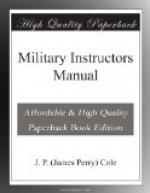Contours are always at equal elevations from each other, and the Vertical Interval (known by the abbreviation V.I.) is the measure between successive contour lines. In military maps the V.I. is always the same for each map scale:
1 inch to the mile, the V.I.
is 60 feet.
3 inch to the mile, the V.I.
is 20 feet.
6 inch to the mile, the V.I.
is 10 feet.
12 inch to the mile, the V.I. is
5 feet.
Note that the V.I. changes in proportion to the scale, a map on a 3 inch to the mile scale is 3 times as large as one on a scale of 1 inch to the mile, while the V.I. is 1/3 as great, hence the former shows 3 times as many contours as the latter.
Map Distance means the horizontal distance between two contour lines on a map and indicates a certain degree of slope. As the scale increases the V.I. decreases in proportion and the M.D. therefore remains the same for the same degree of slope whatever the scale of the map. By computation we find that a one degree slope rises one foot for every 57.3 feet horizontal distance, so a one degree slope would have a 20 foot rise in 1,146 feet horizontal distance, this distance equals .65 of an inch on the map if the scale is 3” to 1 mile.
The term “Map Distance” is also loosely used to denote distance between points as measured on the map. Care should be taken to distinguish between these two meanings.
Distances between contours, scale 3” to 1 mile: 1/2 deg. slope = 1.3”, 1 deg. slope =.65”, 2 deg. slope =.32”, 3 deg. slope =.22”. These distances are already on the alidade and if you get a slope of 2 deg. with the slope board and have the distance from your station on the map to the point of aim either by pacing, intersection or resection, apply the M.D. scale as many times as it will go. This will give the number of contour lines crossing the traverse and the difference in elevation. The spacing of the contours may not be even between your station and the point of aim in which case the position of the contours must be estimated by eye.
If your elevation above the datum or sea level is unknown at the start assume any elevation which is great enough to put the datum lower than the lowest spot of the area to be sketched.
The sketching board is easily made to serve as a slope board in this manner. Hang a plumb bob about an inch below the center of a straight edge of the board while pointing at the horizon, using the back of the board. Mark a point 5.7” directly below and draw a semicircle through it with the same radius. Now mark the point below the center zero and from it divide the arc using chords one tenth of an inch long. This will give a scale reading in degrees. By sighting along the top of the board at some object at the height of the eye from the ground the degree of slope is shown by the plumb bob on the scale below. Care must be exercised to prevent the wind from disturbing the reading. A protractor may be used in the same manner by sighting along the top and using a plumb bob to record the angle.




